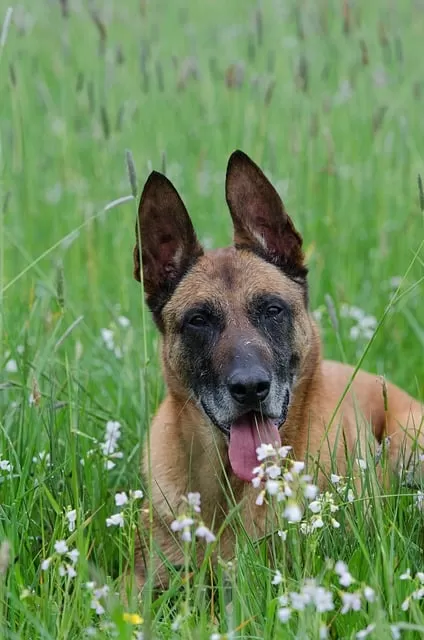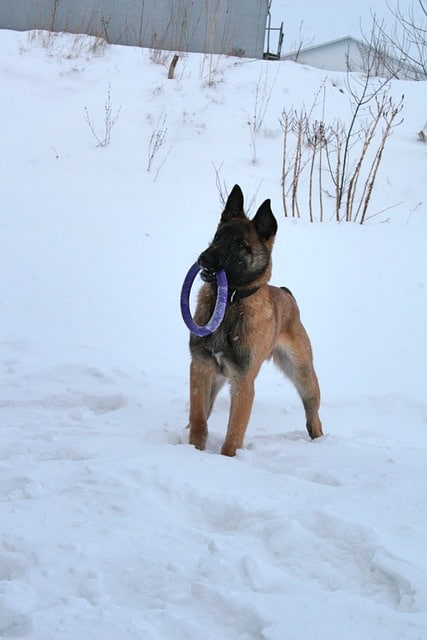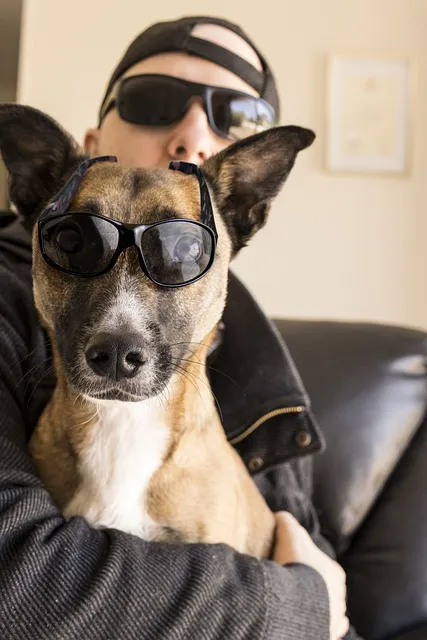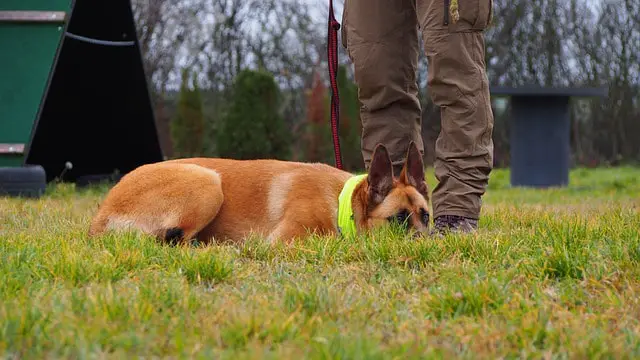As, a puppy, any breed of dog that you choose as a companion requires training. Dogs are not born obedient, well-behaved, or the perfect family pet. Sure, puppies are adorable but all of that cuteness only gets you so far!
The Belgian Malinois puppy is no exception to the rule. They are sweet playful puppies but do need all-around training.
In this post, I will list some tips on how to train a Belgian Malinois puppy, how to potty train a Belgian Malinois puppy, and also how to train a Belgian Malinois puppy not to bite.
The Belgian Malinois
The Belgian Malinois originated in Malines, Belgium, and was bred primarily to herd sheep. Because of this herding nature and guarding instinct, they are used worldwide by law enforcement and the military, making excellent K-9 partners.
With these inner guarding and protecting qualities, they can make excellent pets, but they may need a bit more training than other breeds for a nice fit into the family unit.
The Belgian Malinois is accustomed to being a busy working dog, so being left alone and becoming bored can prove destructive although this can be the case in other breeds as well. Boredom equals problem behavior.

For your dog’s vitamin supplement, food, toys, or other dogs product please visit the Sundays for dogs website.
How To Potty Train a Belgian Malinois Puppy
The very first part of training your Belgian puppy begins as soon as you bring your puppy into your home and this is potty training or housebreaking.
You should begin by taking your pup outside every 20 to 30 minutes and especially after feeding.
Designate a certain area in your yard specifically for bathroom purposes and take them to this spot every time.
When they are successful give them positive reinforcement with plenty of praise and a treat if you like.
Your puppy will probably have some accidents, but remember, they are just puppies and can’t hold “it” very long. If you catch them in the act, simply say “no,” and whisk them outside to finish.
If you don’t see it happen, just clean it up. Scolding them after the fact will serve no purpose. They won’t understand what they did wrong.
If you see them circling and sniffing, this is a signal to get them outside to their spot, Never yell, hit them, or rub their nose in it.
Use only positive words and an excited tone of voice and soon they will be letting you know when they need to go out.
To check your Belgian Malinois Puppies’ health status or their DNA, please visit the Embark vet website for all the help you may needs.

Basic Training For Belgian Malinois Puppies
Here are a few tips for training your Belgian puppy right from the start.
Prepare – Be prepared before you bring your Belgian Malinois puppy home by having any necessary items you will need for training and to make your new puppy feel comfortable, safe, and secure. Items needed will be the bed, blanket, toys, dishes, food, collar, leash, and a crate or baby gate.
Your puppy should not be free to roam all over your house until they are trained and older. If you allow this, you are setting yourself up for messes everywhere. They may have accidents or chew things that cannot be replaced.
Either create trains for your pup or keeps them in a room with a baby gate. Crates are a good way to acclimate them to your household and a place where they are safe if you need to go out.
You can begin by keeping their essentials, bed, blanket, etc., in the crate and leaving the door open for them to come and go.
Then practice closing the door for a few minutes, gradually increasing the time. You’ll find that puppies will like the cozy, safe feeling in their crate and will often go inside to nap or get away from the noise.
Socialization Puppy Training
Socialization – Socialization is, in fact, a type of training, to ensure a calm, well-mannered adult Malinois.
Your Belgian should be exposed to as many different people, dogs, and situations as possible, so they can grow into a friendly pup, that is not shy or afraid and can handle anything.
Take your puppy along with you on your travels and while doing errands if you are able. Formal puppy training classes are an excellent way for you to get the training ball rolling, especially if you are unsure where to start. These classes will also help to socialize puppies with other people and dogs.

Puppy training basic commands
Basic commands – You can begin training your Belgian Malinois puppy at 8 weeks with basic commands like “come,” “sit,” and “stay.” This is not only good to start training early but to create a close bond with you.
Don’t expect perfection because they are still very young and keep the training sessions short.
Puppies have a limited attention span and they get tired too! Give plenty of praise when they do what is asked and never scold them.
Keep a positive attitude. As they get older they should also learn, “drop it,” and “leave it,” two very important commands if your pup should get into something forbidden.
Pet your puppy while they are eating so they don’t develop food aggression. You should always be able to take anything off of your pup without any signs of aggression.
Time, Play, Exercise
Time/play/exercise – Spending time with your puppy is essential for creating a bond. Always be gentle with your pup, never showing anger.
Play games like catch and fetch to keep them active, but also to stimulate their brain. Plenty of exercise is also needed for this breed to keep them in good physical health as well as mental health so they don’t become bored.
Small puppies need exercise but keep play sessions short at first because their bones are still forming.
You don’t want to over-exert or have a rough play. Gradually add exercise time as they get older.
Leash Training Puppy
Collar/leash training – You can start to acclimate your puppy to a collar early on. Put it on them and leave it on for short periods of time, gradually increasing it until they are used to it. A collar and tags are very important if your puppy should become lost.
Practice with the leash by clipping it on and letting the puppy drag it around so they can get accustomed to it. Then you can start walking them.
If the puppy bites and pulls on the leash don’t get into a tug-of-war. Drop the leash until the puppy settles and then begin again. They will soon equate their leash with fun and adventure.
Take a Control
Begging – Don’t allow your puppy to be at or near the table while the family is eating. As the pack leader, you should eat before your puppy and they also need to learn that people’s food is off-limits.
Designate a place for your pup until you are finished eating. When snacking in front of the television, pups may have a treat of their own, but if you start giving your puppy potato chips and popcorn, it will not only be bad for their health but they will begin begging every time you snack. If you have guests, the begging will make them feel uncomfortable.
How to Train a Belgian Malinois puppy not to bite
Biting – All puppies bite or nip. It is a natural habit, especially when teething. This, however, is not something you want to encourage or you will end up with an adult dog that bites; not acceptable behavior.
With your Belgian Malinois, who has that inner guarding instinct, this is something you want to deter. Make sure your pup always has plenty of toys to chew on. Some are made specifically for teething and many are virtually indestructible.
When the puppy becomes too rough in play and nips, squeal, “ouch!” This will stop puppies in their tracks and they will know they hurt you. Then walk away and ignore your puppy even if they whimper or barks.
When they calm down, resume play. Continue to ignore them each time they begin nipping. Don’t scold or yell, simply say, “ouch” and walk away. Puppies will soon get the idea that when they bite, they get no attention, good or bad.

Consistency
Consistency – The last tip for training is for you. You must be consistent. Your puppy’s bad behavior can not be cute, funny, and acceptable one minute and wrong the next.
It must always be wrong. If you waffle, your puppy will be confused and you have just set yourself up for an out-of-control Belgian Malinois as they grow.
It is very possible to have a Belgian Malinois puppy for a family dog regardless of their herding and guarding instincts. Consistency, training, patience, time, and love are all needed.
Beginning early with training and covering all of the bases can prevent behavior that is aggressive or territorial and allow you to have an obedient, well-mannered, and loyal Belgian.
If you need help or are unsure where to begin, speak with your puppy’s veterinarian or a professional trainer. Asking for help is a sure way for a well-trained Belgian Malinois.